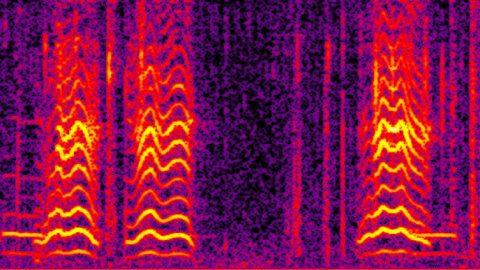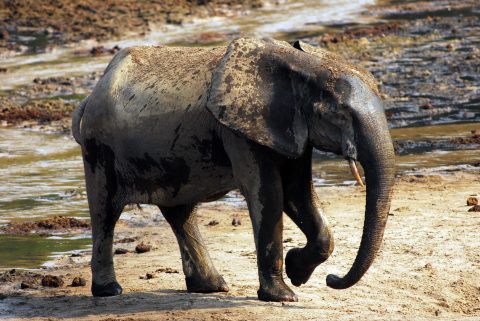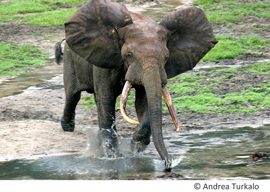Deep into Infrasound
Infrasound is a sound below the range of human hearing. The frequency of sound is measured in Hertz (Hz = cycles per second) and the infrasonic range includes all sounds below 20 Hz. Want to test your own hearing? Below are three computer-generated pure tones. Most of you will hear the 30 Hz tone, but to hear 20 Hz, at the limit of human hearing, you might need headphones/earbuds!
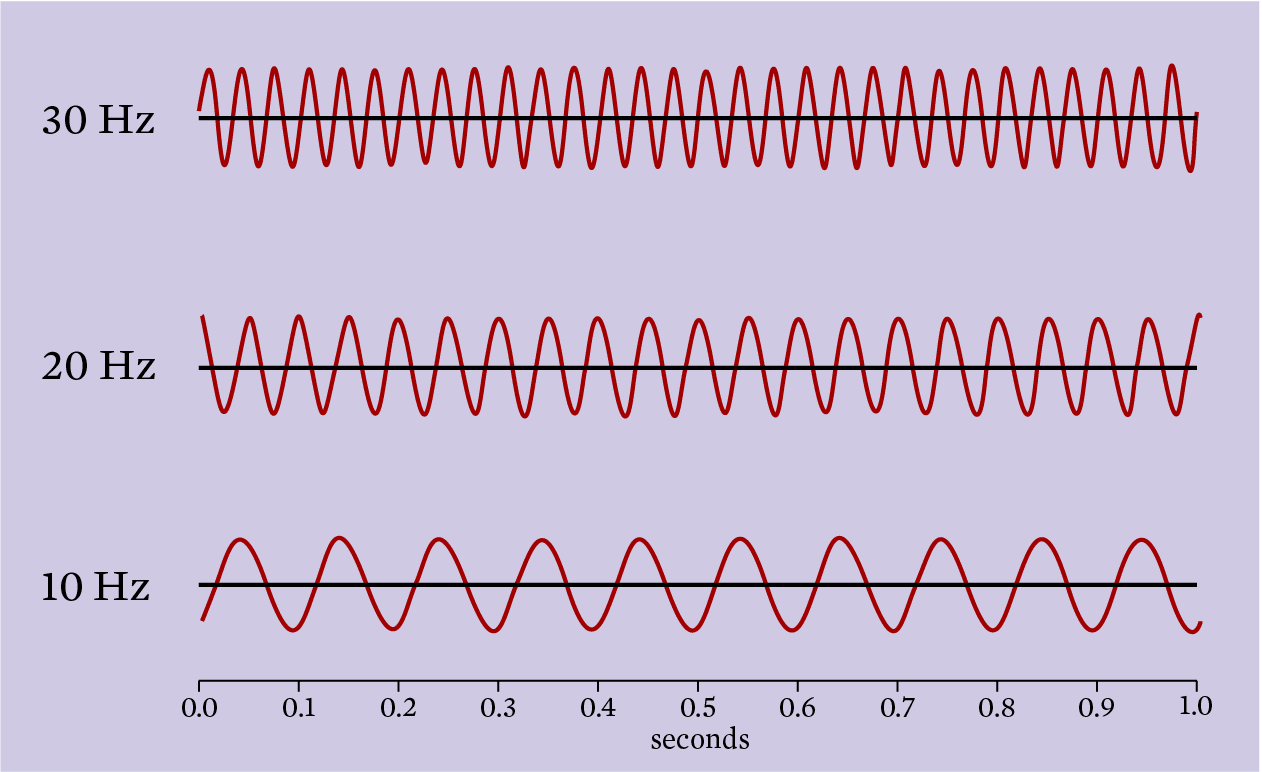
Quick Facts
- All adult elephants can make infrasonic calls.
- Elephant rumbles usually have many harmonics – multiples of the fundamental frequency – and humans can hear these if the call is loud.
- Other animals that produce infrasonic calls include whales, rhinoceros, giraffes, and alligators.
- Infrasound is also produced by volcanic eruptions, earthquakes, avalanches, and the calving of icebergs.
- Human activities that produce infrasound include the props of large ships, sonic booms, and wind turbines.
- Infrasonic calls may travel long distances – even across the Atlantic Ocean from South America to Africa in the case of the blue whale!
How did we find out that elephants use infrasound?
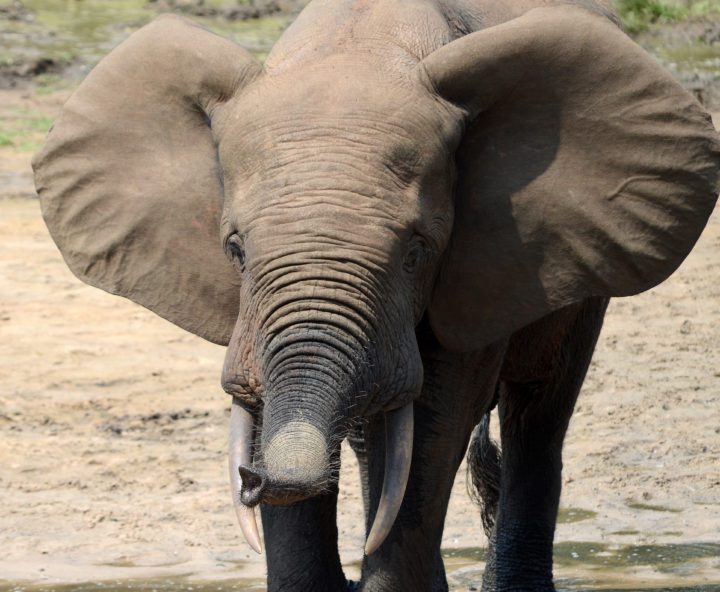
The discovery of infrasonic communication among elephants came from a hunch Katy Payne had while visiting the Washington Park Zoo in Portland, Oregon. As she observed the Asian elephants, Katy sensed a thrumming vibration in the air and surmised she was feeling, rather than hearing, the elephants communicating.
Further work at the zoo with William Langbauer Jr. and Elizabeth Thomas revealed that elephants were indeed making infrasonic calls (1). This was later confirmed with playback experiments on wild African elephants in collaboration with Russel Charif, Lisa Rapaport, and Ferrel Osborn (2). It was concluded that elephants use their powerful, deep calls in long distance communication to coordinate group movements and to find individuals in reproductive condition. Fascinating observations of elephants in the extremely dry region of Namibia, by Michael Garstang and colleagues, suggests that they might use the infrasound produced by distant thunderstorms to find water during drought periods (3).
Forest elephants and infrasound
Playback experiments on the savannahs of East Africa demonstrated that savannah elephants responded to each other’s vocalizations over distances of 2 km and, because it is hard to reproduce elephant calls as loudly as the elephants themselves can call, Langbauer, Payne and colleagues estimated the actual detection range to be 4 km (2). This means that an elephant rumble could reach family members anywhere in a 50 sq.km area around the caller!
The timing, frequency, and power (loudness or amplitude) of elephant vocalizations turns out to be important as well. The propagation of very low frequency sound can vary with atmospheric conditions, wind speed and direction, and characteristics of the ground on which the elephants are standing. In addition, detection of calls by a receiver is affected by background sounds in the environment. On a typical dry season evening in the savannah a temperature inversion forms that essentially acts like a ceiling and bounces sound waves back down toward the ground (and receiver), potentially increasing the listening area of elephants as much as ten-fold — from 30 sq. km. at midday to 300 sq. km. in the same evening (4). In light of this fact it is interesting that savannah elephants make most of their loud low-frequency calls during the hours of best sound propagation (4). We do not know whether this is an innate or opportunistic response to fluctuations in the size of their communication area, but in either case it is clear that as the area shrinks and expands, so does the network of potential associates and mates that could be reached acoustically.
In the forest there are even greater challenges! In the environment roamed by forest elephants there might not be as much of a problem with the disruptions of wind on sound propagation, but the density and diversity of other acoustically active species makes for a very loud background. Still, as shown in the cartoon below, the low frequencies in elephant rumbles do still travel a long way through the forest, even though the trees can be so dense that the elephants are impossible to see.

ELP recently measured how well forest elephant rumbles travel through the rainforest in Central Africa. We used the recordings from an acoustic array, spread out around a forest clearing in Gabon. The array allowed us to pinpoint spatially where each recorded call was produced, and from this we could calculate the distance that the call had to travel to each of the recording units. Recorders were different distances from each call and so by measuring the amplitude of the call at each distance we could estimate how much energy was lost as the sound traveled through the forest.
We estimated much smaller detection distances for the average rumble in this rainforest environment compared to the savannah – only about 800 meters (not 4 kilometers). But this was almost entirely due to the relatively high level of the background noise against which an elephant would need to recognize the rumble. When the forest was at its most quiet, a rumble might be detected at distances of more than 3 km. This has large implications for how forest elephants coordinate interactions among subgroups of the family and between potential mates (5).
How different is this finding from what has been found with savannah elephants? Possibly not as different as it would first appear. Experiments in the savannah were mostly conducted under optimal environmental conditions with little or no wind. And unlike the savannah studies, which used playback experiments to determine behaviorally whether the elephants discriminated the call, we had to make assumptions about the hearing sensitivity of the elephants, something that has never been precisely measured. There are some theoretical reasons to think that animals are very good at extracting acoustic signals from the background, so forest elephants might do much better than we assumed.
Explore Forest Elephant Communication
References:
1. Payne, K.B., W.R. Langbauer, E.M. Thomas (1986). Infrasonic calls of the Asian elephant (Elephas maximus). Behav. Ecol. Sociobiol. 18(4):297-301
2. Langbauer, W.R., et al. (1991). African elephants respond to distant playbacks of low-frequency conspecific calls. J. Exper. Biol. 157:35-46
3. Garstang M., et al. (2014). Response of African elephants (Loxodonta africana) to seasonal changes in rainfall. PlosOne 9(10):e108736
4. Larom, D., et al. (1997). The influence of surface atmospheric conditions on the range and area reached by animal vocalizations. J. Exp. Biol. 200: 421-431
5. Hedwig, D., M. DeBellis, P.H. Wrege (2018). Not so far: attenuation of low-frequency vocalizations in a rainforest environment suggests limited acoustic mediation of social interaction in African forest elephants. Behav. Ecol. Sociobiol. 72(3).


